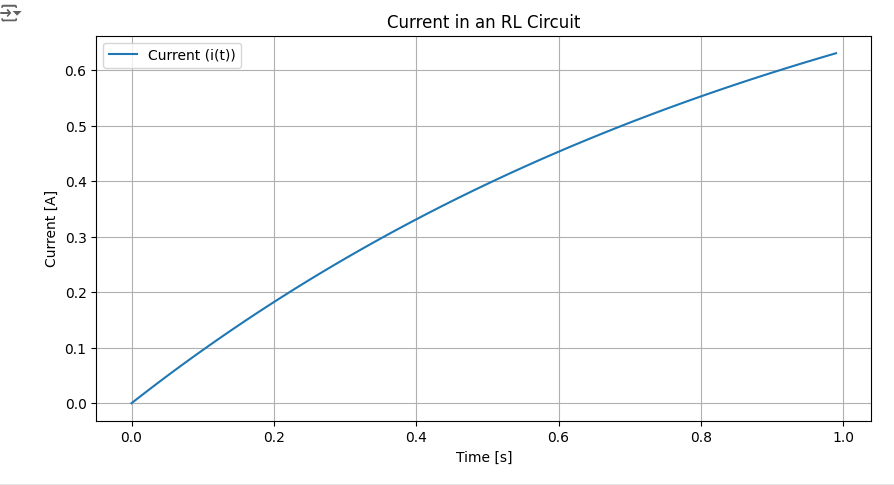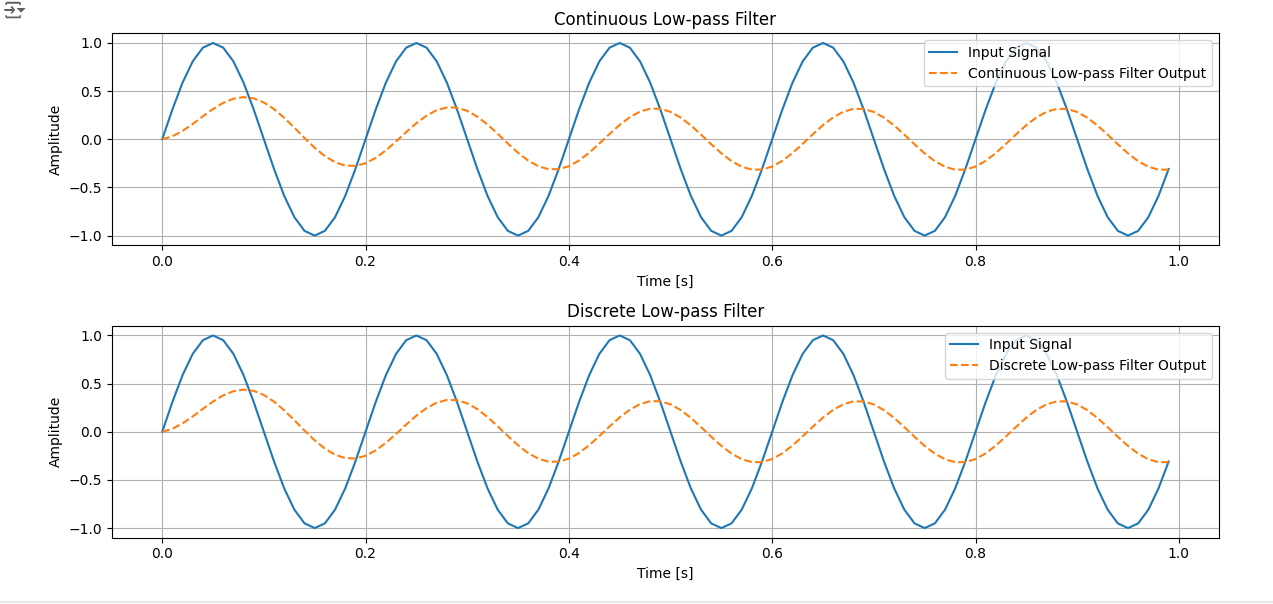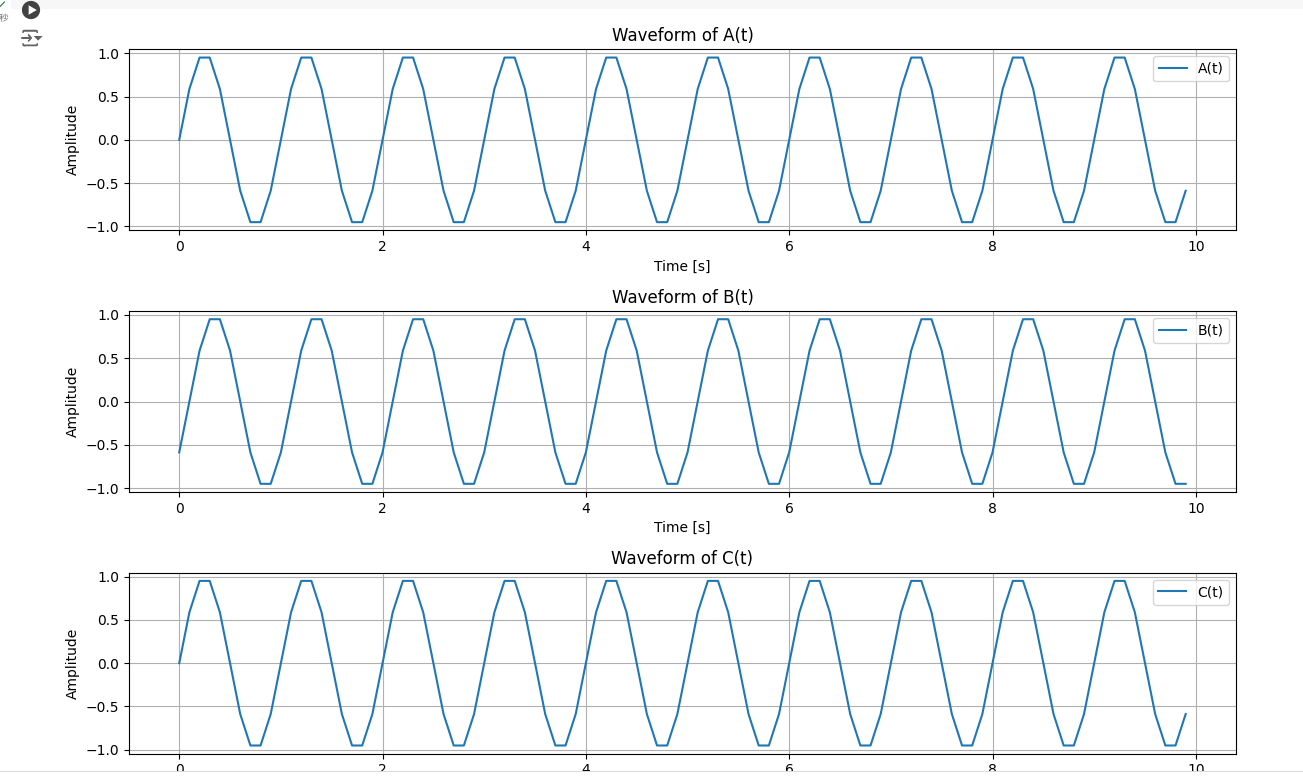import numpy as np
import matplotlib.pyplot as plt
# フィルターのパラメータ
T = 1.0 # サンプリング周期
C = 1.0 # 容量
R = 1.0 # 抵抗
# フィルター係数の計算
T1 = T / (C * R)
# ローパスフィルターの係数
a_lp = 1 / (1 + T1)
b_lp = T1 / (1 + T1)
# ハイパスフィルターの係数
b_hp = 1 - T1
# 周波数レンジ
frequencies = np.logspace(-1, 2, 400) # 0.1Hzから100Hzまでの範囲
omega = 2 * np.pi * frequencies * T
# 周波数応答の計算
H_lp = (a_lp + b_lp * np.exp(-1j * omega)) / (1 - b_lp * np.exp(-1j * omega))
H_hp = (1 - np.exp(-1j * omega) + b_hp * np.exp(-1j * omega)) / (1 - b_hp * np.exp(-1j * omega))
# プロット
plt.figure(figsize=(12, 6))
# ローパスフィルターの周波数応答
plt.subplot(1, 2, 1)
plt.title('Low-Pass Filter Frequency Response')
plt.semilogx(frequencies, 20 * np.log10(np.abs(H_lp)))
plt.xlabel('Frequency [Hz]')
plt.ylabel('Magnitude [dB]')
plt.grid(which='both', linestyle='--', linewidth=0.5)
# ハイパスフィルターの周波数応答
plt.subplot(1, 2, 2)
plt.title('High-Pass Filter Frequency Response')
plt.semilogx(frequencies, 20 * np.log10(np.abs(H_hp)))
plt.xlabel('Frequency [Hz]')
plt.ylabel('Magnitude [dB]')
plt.grid(which='both', linestyle='--', linewidth=0.5)
plt.tight_layout()
plt.show()
import numpy as np
import matplotlib.pyplot as plt
# パラメータの定義
L = 1.0 # インダクタンス (H)
R = 1.0 # 抵抗 (Ohm)
T = 0.01 # サンプリング周期 (s)
E = 1.0 # 定電圧 (V)
time_duration = 1.0 # シミュレーション時間 (s)
# 時間のベクトル
t = np.arange(0, time_duration, T)
N = len(t)
# 電流のベクトル
i = np.zeros(N)
# オイラー法で微分方程式を解く
for k in range(1, N):
di = (T / L) * (E - R * i[k-1])
i[k] = i[k-1] + di
# プロット
plt.figure(figsize=(10, 5))
plt.plot(t, i, label='Current (i(t))')
plt.title('Current in an RL Circuit')
plt.xlabel('Time [s]')
plt.ylabel('Current [A]')
plt.grid()
plt.legend()
plt.show()
import numpy as np
import matplotlib.pyplot as plt
def low_pass_filter_continuous(K, T, u, t):
"""連続時間ローパスフィルターのシミュレーション"""
dt = t[1] - t[0]
y = np.zeros_like(u)
x = np.zeros_like(u)
for i in range(1, len(t)):
dx = (1/T) * (K * u[i] - x[i-1])
x[i] = x[i-1] + dx * dt
y[i] = x[i]
return y
def low_pass_filter_discrete(K, T, Ts, u):
"""離散時間ローパスフィルターのシミュレーション"""
y = np.zeros_like(u)
x = np.zeros_like(u)
alpha = Ts / T
for n in range(1, len(u)):
x[n] = (1 - alpha) * x[n-1] + K * alpha * u[n]
y[n] = x[n]
return y
# パラメータの定義
K = 1.0 # フィルターのゲイン
T = 0.1 # フィルターの時定数
Ts = 0.01 # サンプリング時間
t = np.arange(0, 1, Ts) # シミュレーション時間
u = np.sin(2 * np.pi * 5 * t) # 入力信号 (5Hzのサイン波)
# 連続時間フィルターのシミュレーション
y_cont = low_pass_filter_continuous(K, T, u, t)
# 離散時間フィルターのシミュレーション
y_disc = low_pass_filter_discrete(K, T, Ts, u)
# プロット
plt.figure(figsize=(12, 6))
plt.subplot(2, 1, 1)
plt.plot(t, u, label='Input Signal')
plt.plot(t, y_cont, label='Continuous Low-pass Filter Output', linestyle='--')
plt.title('Continuous Low-pass Filter')
plt.xlabel('Time [s]')
plt.ylabel('Amplitude')
plt.legend()
plt.grid()
plt.subplot(2, 1, 2)
plt.plot(t, u, label='Input Signal')
plt.plot(t, y_disc, label='Discrete Low-pass Filter Output', linestyle='--')
plt.title('Discrete Low-pass Filter')
plt.xlabel('Time [s]')
plt.ylabel('Amplitude')
plt.legend()
plt.grid()
plt.tight_layout()
plt.show()
import numpy as np
import matplotlib.pyplot as plt
# Parameters
T = 0.1 # Sampling period
t = np.arange(0, 10, T) # Time vector
# Analog sine signal
A = np.sin(2 * np.pi * t)
# C is the same as A (A + B = C)
C = A
# B is C delayed by period T
B = np.roll(C, int(T / (t[1] - t[0])))
# Plot the waveforms separately
plt.figure(figsize=(12, 8))
# Plot A(t)
plt.subplot(3, 1, 1)
plt.plot(t, A, label='A(t)')
plt.xlabel('Time [s]')
plt.ylabel('Amplitude')
plt.title('Waveform of A(t)')
plt.legend()
plt.grid(True)
# Plot B(t)
plt.subplot(3, 1, 2)
plt.plot(t, B, label='B(t)')
plt.xlabel('Time [s]')
plt.ylabel('Amplitude')
plt.title('Waveform of B(t)')
plt.legend()
plt.grid(True)
# Plot C(t)
plt.subplot(3, 1, 3)
plt.plot(t, C, label='C(t)')
plt.xlabel('Time [s]')
plt.ylabel('Amplitude')
plt.title('Waveform of C(t)')
plt.legend()
plt.grid(True)
plt.tight_layout()
plt.show()
import numpy as np
import matplotlib.pyplot as plt
# Parameters
T = 0.1 # Sampling period
t = np.arange(0, 10, T) # Time vector
# Analog sine signal
A = np.sin(2 * np.pi * t)
# B is the same as A (A + C = B)
B = A
# C is B delayed by period T
C = np.roll(B, int(T / (t[1] - t[0])))
# Plot the waveforms separately
plt.figure(figsize=(12, 8))
# Plot A(t)
plt.subplot(3, 1, 1)
plt.plot(t, A, label='A(t)')
plt.xlabel('Time [s]')
plt.ylabel('Amplitude')
plt.title('Waveform of A(t)')
plt.legend()
plt.grid(True)
# Plot B(t)
plt.subplot(3, 1, 2)
plt.plot(t, B, label='B(t)')
plt.xlabel('Time [s]')
plt.ylabel('Amplitude')
plt.title('Waveform of B(t)')
plt.legend()
plt.grid(True)
# Plot C(t)
plt.subplot(3, 1, 3)
plt.plot(t, C, label='C(t)')
plt.xlabel('Time [s]')
plt.ylabel('Amplitude')
plt.title('Waveform of C(t)')
plt.legend()
plt.grid(True)
plt.tight_layout()
plt.show()




